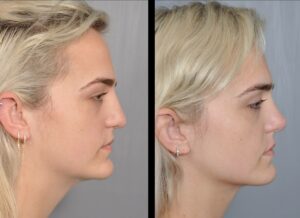The bony structure of our facial features plays an important role in determining one’s appearance. Facial implants can strengthen or enhance areas that lack definition, volume, or projection. Common facial implants include but are not limited to cheek/tear trough implants, chin implants, and angle implants.
Visit the Chin Implant Before and After Gallery
Chin Implants
Proper chin projection, symmetry, and proportion are integral to overall facial harmony. Chin implants are a great way for a patient to achieve additional height, width, and projection while providing a stronger, better-defined profile.
Cheek Implants/Tear Trough Implants
Facial implants are commonly used in facial plastic surgery to enhance your appearance or improve your facial contour. One of the strongest characteristics of youth is the fullness of the cheeks, indicating an abundance of healthy soft tissue and healthy fat under the skin. The cheekbones are largely responsible for defining your face, highlighting the eyes and adding balance to your features. People who most commonly have cheek implants have underdeveloped cheekbone structure or have lost soft tissue due to the normal aging of the face. Cheek implants usually add aesthetically pleasing contours to your face while the results are permanent.
Common Questions About Chin Implants
How is the procedure performed?
A chin implant is usually placed through a small incision just beneath the chin. A pocket is created to receive the implant, which is then slipped into place and secured to the underlying jawbone. After placement, the incision is closed with fine sutures to minimize scarring. This outpatient procedure takes 30-60 minutes and is typically performed under anesthesia.
What about recovery?
Following chin augmentation, you will experience some discomfort and swelling for several days. Mild discomfort is usually easily controlled with medication. Keeping your head elevated and applying cold compresses for a day or two will keep swelling to a minimum.
Are implants safe?
Chin augmentation has proven to be a relatively simple, safe, and predictable cosmetic procedure. To date, millions of implants made from solid silicone or Porex® have been safely implanted without an allergic reaction. These implants come in a wide variety of sizes and shapes and can be custom-trimmed for a more natural fit.
How can Liposuction help?
Many people with a receding chin also have an accumulation of fat below it resulting in a”double chin” appearance. At the time of chin augmentation, FaceTite with Liposuction can be performed to remove excess fat from under the chin to better define the jawline and give a more balanced profile. By combining FaceTite and Liposuction with a Chin Implant, a patient can achieve contouring and added definition, making it an ideal companion to chin implant surgery.
Common Questions About Cheek Implants
Is this a surgical procedure?
In some cases, facial implant surgery may require only local anesthesia combined with a sedative. However, more frequently, general anesthesia may be recommended.
How long will Cheek implant surgery take?
Cheek implant surgery usually takes about 30 to 45 minutes.
Where are the incisions?
A small incision will be made on the inside of your lower eyelid. A pocket is then formed and an implant is inserted.
What about recovery?
The recovery period after facial implants is relatively short with many patients resuming normal activities within a few days. Once fully healed, the implant feels like your normal underlying bone structure.
What are the risks?
As with any surgery, you can expect some swelling, mild bruising and minimal pain. You should be aware that your ability to move your mouth and lips may be diminished temporarily. Stitches used to close the incisions usually dissolve within about 10 days. Typical cheek implant procedures create some numb areas around the cheeks and mouth but they rarely last long.











